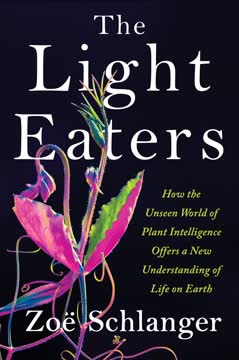つの重要なポイント
1. 木々は孤立した個体ではなく、相互に結びついたネットワークである
生命は具現化されたネットワークである。これらの生きたネットワークは、全てが善意に満ちた一体性の場所ではない。むしろ、協力と対立の間の生態学的および進化的な緊張が交渉され、解決される場所である。
コミュニティとしての木々。 木々は孤立した生物ではなく、他の植物、菌類、微生物、動物と複雑に結びついたネットワークを形成している。この関係の網は、木々が資源を共有し、脅威を伝え、広範な生態系を支えることを可能にする。例えば:
- 菌根菌は木の根と共生関係を形成し、その範囲と栄養吸収能力を拡大する
- 木々は根や空気を通じて化学信号を送り、昆虫の攻撃を互いに警告することができる
- アマゾンのセイボのような木々は、生物多様性の中心として機能し、その樹冠に数百種の他の生物を宿す
生態学的バランスの取れた行動。 これらのネットワークは純粋に協力的なものではなく、資源の競争や複雑な進化的トレードオフも含まれる。協力と対立の間の緊張が適応を促し、時間とともに生態系を形作る。
2. 都市の木々は都市生活に適応し、空気を浄化しコミュニティを結びつける
必要は良い教師である。
都市森林の利点。 都市の木々は多くの生態系サービスを提供する:
- 大気汚染のフィルタリングと酸素の生成
- 都市のヒートアイランド効果の軽減
- 雨水の管理
- 都市野生生物の生息地の提供
- 精神的健康とコミュニティの結びつきの向上
都市生活への適応。 都市の木々は、圧縮された土壌、大気汚染、限られた根のスペースなど、独自の課題に直面している。彼らは様々な適応を発展させてきた:
- カレーペアの木はその組織内で重金属を解毒することができる
- ロンドンプラネタリーの木は蓄積された汚染物質を除去するために樹皮を剥がす
- 多くの都市の木々は、都市の峡谷で風に対抗するためにより強固な根系を持っている
都市で繁栄する木々は、カレーペアの厳しい中国の風景に起源を持つように、挑戦的な環境に備えた進化の歴史を持っていることが多い。
3. 古代の森林は地球の気候の歴史と将来の可能性を明らかにする
聞くことは、風景の皮膚に聴診器を当て、下で何が動いているかを聞くことである。
地質学的タイムカプセル。 化石として保存された古代の森林は、過去の気候や生態系について貴重な洞察を提供する:
- コロラド州のフロリサント化石床は、3400万年前の森林を保存し、はるかに暖かく湿った気候を明らかにする
- 年輪、花粉記録、その他の植物化石は、過去の環境条件を再構築するための手がかりを提供する
気候変動の影響。 これらの古代の森林を研究することで、以下のことが理解できる:
- 生態系が劇的な気候変動にどのように対応するか
- 現在の地球温暖化の傾向の潜在的な影響
- 異なる木の種の回復力と適応力
この知識は、現代の森林や生態系に対する人為的な気候変動の影響を予測し、可能な限り緩和するために重要である。
4. 木々のコミュニケーションは化学信号と菌類ネットワークを通じて行われる
多くの解釈者が待っている言語、特に多くのことを伝える言語のように、空の言語的基盤は形の豊かさで表現される。
化学的会話。 木々はさまざまな化学信号を通じてコミュニケーションを行う:
- 空気中の揮発性有機化合物は、近くの木々に昆虫の攻撃を警告する
- 根の分泌物は土壌を通じて隣接する植物にメッセージを送る
- 葉は昆虫の咀嚼の振動を検知し、化学的防御を行う
ウッドワイドウェブ。 広大な地下の菌根菌ネットワークは木々を結びつけ、以下のことを可能にする:
- 栄養素と水の共有
- 干ばつや病気についての緊急信号の送信
- 強い木から弱い木や若い木への資源の支援
この複雑なコミュニケーションシステムは、森林がスーパーオーガニズムとして機能し、脅威や変化する条件に集団で対応することを可能にする。
5. 木々との人間関係は文化と経済を形作る
私たちは生命の歌の外に出ることはできない。この音楽が私たちを作り、それが私たちの本質である。
文化的意義。 木々は多くの人間文化において中心的な役割を果たす:
- さまざまな宗教の聖なる森
- レバノンの杉やカナダのメープルリーフのような国の象徴
- 伝統的な薬や食物としての木々
経済的重要性。 木々は多くの経済にとって重要である:
- 木材産業
- 果物やナッツの生産
- 炭素隔離や水の浄化などの生態系サービス
- 森林や公園での観光
変わりゆく視点。 木々との関係は進化している:
- 気候変動対策における木々の役割の認識の高まり
- 世界中の都市での都市林業の取り組み
- 森林管理における先住民の知識の取り入れ
これらの深い関係を理解することで、より持続可能で文化的に敏感な森林管理と保全のアプローチが可能になる。
6. 森林破壊と気候変動は世界中の木々の生態系を脅かす
私たちは皆—木々、人間、昆虫、鳥、細菌—複数性である。生命は具現化されたネットワークである。
森林破壊の影響。 森林の喪失は広範な影響をもたらす:
- 無数の種の生息地の破壊
- 水循環の混乱と土壌侵食の増加
- 貯蔵された炭素の放出、気候変動の悪化
気候変動の脅威。 気温の上昇と降水パターンの変化は、多くの森林生態系にとって存在の脅威をもたらす:
- 木の種の適応範囲の変化
- 害虫や病気に対する脆弱性の増加
- より頻繁で激しい山火事
相互に関連する課題。 森林の健康は、地球規模の環境問題と切り離せない:
- 生物多様性の喪失
- 食料安全保障
- 人間の健康と生計
これらの課題に対処するには、生態系と人間社会の相互関連性を考慮した全体的なアプローチが必要である。
7. 木々に耳を傾けることで、より深い生態学的理解とつながりを育むことができる
木々、自然の偉大なつなぎ手に耳を傾けることは、生命の源、実質、美しさを与える関係を学ぶことである。
感覚的な関与。 木々に真に耳を傾けることは、単に聞くこと以上のものを含む:
- 葉、花、果実の季節の変化を観察する
- 樹皮や葉の質感を感じる
- 種類ごとの独特な香りを嗅ぐ
科学的洞察。 木々の注意深い観察は以下を明らかにする:
- 地域の環境条件と時間の経過による変化
- さまざまな昆虫、鳥、その他の野生生物の存在
- 広範な生態系の健康
個人的な変容。 木々に耳を傾ける習慣を身につけることで:
- 地元の環境への意識が高まる
- 自然とのつながりを感じる
- 保全活動や環境保護の意欲が湧く
木々との深い関与は、生態系とその中での私たちの位置についてのより全体的な理解をもたらすことができる。
8. 盆栽の芸術は人間と木々の生活の絡み合いを象徴する
未来、展開する目的は、木の種や人間の心の中に含まれているのではなく、生きた関係の糸の中にその起源と実質を持つ。
ミニチュア化の芸術。 盆栽は単なる小さな木を育てること以上のものである:
- 木の生物学と成長パターンの深い理解が必要
- 剪定や形作りが数十年にわたって木にどのように影響するかを予測する必要がある
- この芸術形式は、バランス、調和、不完全さの原則を体現している
文化的意義。 盆栽は哲学的および美学的伝統を反映している:
- 日本の侘寂(不完全さの中の美)の概念
- 中国の盆景の伝統、ミニチュア風景の創造
- 木を育てることにおける瞑想的な実践と忍耐
人間と木の協力。 盆栽は人間の手入れが木の生活をどのように形作るかを象徴している:
- 木は剪定や配線に応じて成長パターンを変える
- 盆栽の芸術家と木の関係は世代を超えることがある
- 盆栽の木はしばしばその人間の世話人を超えて生き続け、継続的な手入れが必要
この芸術形式は、人間と木の間の深い、相互に変容する関係の可能性を強調している。
9. 木の多様性は進化の歴史と地域の条件への適応を反映している
食べ物やワインが口の中にあるように、言葉が心の中にあるように、触覚には多くの待っている聞き手、多くの次元がある。
進化の遺産。 今日見られる木の種の多様性は、何百万年もの進化の結果である:
- 異なる気候、土壌、生態的ニッチへの適応
- 花粉媒介者、種子散布者、その他の種との共進化
- 過去の気候変動や地質学的出来事への対応
地域適応。 木々は特定の環境で繁栄するために専門的な特性を発展させてきた:
- 砂漠の種の乾燥耐性
- 沿岸の木々の塩耐性
- 火災が頻発する生態系の種の耐火性
生物地理学。 木の種の分布は、大陸の移動、気候変動、人間の影響の物語を語る:
- 古代の陸地のつながりによる北米東部と東アジアの森林の類似性
- 孤立した島々の独特な種
- 農業や都市化などの人間活動による木の分布の変化
この多様性とその起源を理解することは、保全努力や将来の環境変化に対する森林の反応を予測するために重要である。
10. 保全努力は生態学的および文化的要因の両方を考慮する必要がある
生物学や地質学の騒動の中に客観的な倫理的内容があるならば、それは人間が立ち会って判断するかどうかに関係なく存在する。
全体的なアプローチ。 効果的な保全戦略は以下を統合する必要がある:
- 生態系機能の科学的理解
- 文化的価値と伝統的な生態学的知識
- 経済的現実と人間のニーズ
優先順位のバランス。 保全はしばしば困難なトレードオフを伴う:
- 生物多様性の保護と人間の資源ニーズのバランス
- 生態系の回復と現在の土地利用の維持
- 個々の種に焦点を当てるか、全体の生態系アプローチを取るか
コミュニティの関与。 成功する保全努力は通常、以下を必要とする:
- 意思決定プロセスへの地域コミュニティの関与
- 伝統的な知識と実践の取り入れ
- 保全のための経済的インセンティブの提供
グローバルな視点。 木の保全はグローバルな文脈で考慮されるべきである:
- 木の分布と移動に対する気候変動の影響
- 木材やその他の森林製品の国際貿易
- 地球の森林を保護するための共有責任
生態学的および人間的要因の両方を考慮することで、保全努力は人々と森林の間のより回復力のある持続可能な関係を創造することができる。
最終更新日:
FAQ
What's The Songs of Trees about?
- Exploration of tree relationships: The book explores the interconnectedness of trees with their environments, showing how they are part of a larger ecological network.
- Focus on twelve trees: David George Haskell examines twelve trees worldwide, using them to discuss ecological themes and human-nature interactions.
- Integration of science and art: Haskell combines scientific observations with lyrical prose, encouraging readers to listen to the "songs" of trees.
Why should I read The Songs of Trees?
- Deep ecological insights: The book provides profound insights into the ecological roles of trees, emphasizing their importance in sustaining life and biodiversity.
- Beautifully written prose: Haskell's writing is both lyrical and informative, making complex scientific concepts accessible and engaging.
- Philosophical reflections: It encourages readers to reflect on their relationship with nature, fostering a sense of belonging within the ecological community.
What are the key takeaways of The Songs of Trees?
- Interconnectedness of life: The book emphasizes that all life forms, including humans, are interconnected, leading to a deeper appreciation of nature.
- Trees as communicators: Haskell illustrates how trees communicate with each other and their environment through complex networks.
- Human impact on ecosystems: It highlights the detrimental effects of human actions on natural networks, advocating for a harmonious relationship with the environment.
What are the best quotes from The Songs of Trees and what do they mean?
- “To listen is therefore to hear our voices and those of our family.”: This quote emphasizes the importance of listening to nature to understand our place within it.
- “Life is embodied network.”: Haskell encapsulates the idea that life is a web of relationships that sustain and support one another.
- “Our ethic must therefore be one of belonging.”: This calls for recognizing our integral role in the ecological community and acting accordingly.
How does David George Haskell illustrate tree communication in The Songs of Trees?
- Chemical signaling: Trees communicate through chemical signals, sharing nutrients and information with neighboring plants and organisms.
- Fungal networks: Mycorrhizal fungi connect tree roots, facilitating communication and resource sharing among trees.
- Sound and vibration: Haskell explores how trees respond to environmental sounds and vibrations, influencing their growth and health.
What role do humans play in the stories of trees in The Songs of Trees?
- Cultural connections: Haskell highlights the historical and cultural significance of trees in human societies.
- Environmental impact: The book addresses the negative consequences of human activities on tree health and ecosystems.
- Call to action: Haskell encourages stewardship and responsibility towards nature, advocating for sustainable practices.
What specific trees does David George Haskell focus on in The Songs of Trees?
- Diverse selection: Haskell examines trees like the Ceibo in Ecuador and Balsam Fir in Canada, each with unique ecological and cultural narratives.
- Symbolic significance: Each tree is chosen for its biological characteristics and symbolic importance in different cultures.
- Ecological stories: The stories reveal themes of resilience, adaptation, and intricate relationships in forest ecosystems.
How does David George Haskell use personal anecdotes in The Songs of Trees?
- Personal connection: Haskell shares his experiences and observations, creating a relatable narrative for readers.
- Emotional resonance: Anecdotes evoke wonder and loss, highlighting nature's beauty and ecosystem fragility.
- Illustrative examples: Personal stories serve as concrete examples of scientific concepts, making them more accessible.
What scientific methods does David George Haskell employ in The Songs of Trees?
- Field observations: Haskell conducts detailed observations in natural settings, documenting tree behaviors and interactions.
- Interdisciplinary approach: The book integrates ecology, biology, and anthropology for a comprehensive understanding.
- Data analysis: Haskell references scientific studies and data to support his observations, grounding his narrative in research.
How does The Songs of Trees address climate change and its effects on trees?
- Impact on ecosystems: Haskell discusses how climate change alters tree growth patterns and forest health.
- Call for awareness: The book emphasizes the need for awareness and action regarding climate change.
- Hope for resilience: Despite challenges, Haskell highlights trees' resilience and adaptability, offering hope for forests' future.
What role do trees play in human culture according to The Songs of Trees?
- Symbols of life and death: Trees represent growth, resilience, and the life cycle in various cultures.
- Inspiration for art and literature: Trees have inspired art, poetry, and philosophy, enriching cultural heritage.
- Community and connection: Trees serve as gathering places, fostering social interactions and connections.
How does David George Haskell's writing style in The Songs of Trees enhance the reader's experience?
- Descriptive and poetic language: Haskell uses vivid imagery and lyrical prose to immerse readers in nature.
- Personal reflections: He shares thoughts and feelings about trees, creating an intimate connection with readers.
- Interweaving science and narrative: By blending insights with storytelling, Haskell makes complex concepts accessible and engaging.
レビュー
『The Songs of Trees』は、その詩的な文章と深い科学的知識で高く評価されている。読者は、ハスケルが木々を広範な生態学的、文化的、哲学的テーマと結びつける能力を称賛している。本書は世界中のさまざまな樹種を探求し、人間と自然との関係を考察している。文章のスタイルが詩的で洞察に富んでいると感じる人もいれば、時折難解で散漫だと感じる人もいる。多くのレビューアーは、本書が持つ独自の視点と、木々とその生態系における役割に対するより深い理解を促す力を称賛している。
Similar Books










